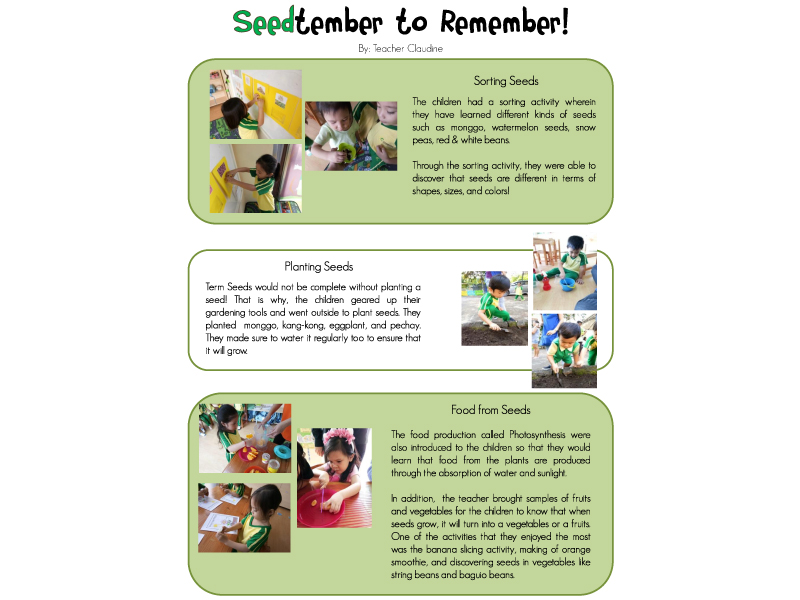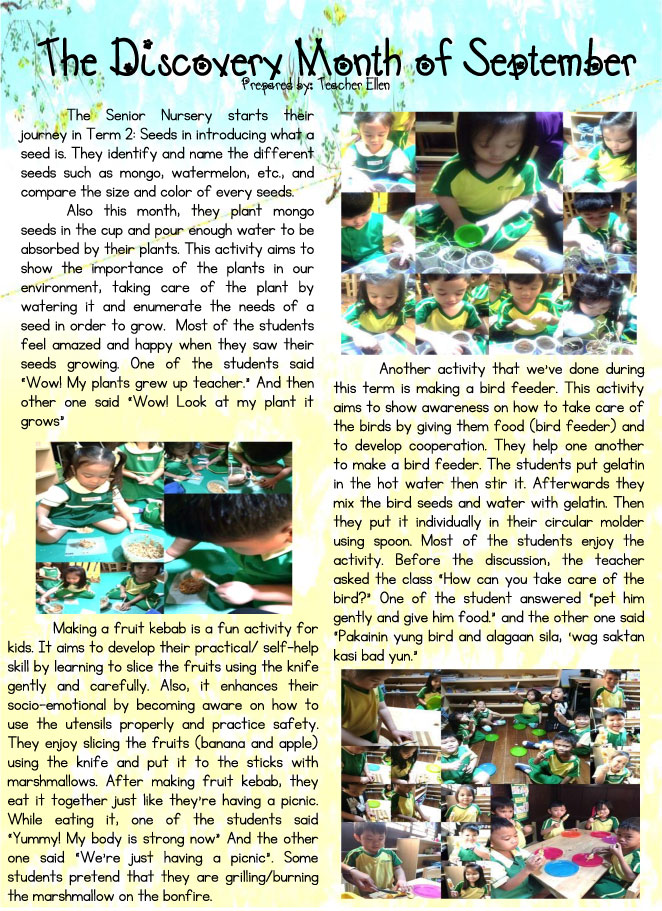
Toddlers – Growing In September
Prepared by: Teacher Justine
The toddler kids kicked start the month of September with so much discoveries and explorations about seeds. The kids got to see, touch, feel, and smell different kinds of seeds. They also got to see different sizes of seeds. They all enjoyed discovering different kinds of seeds as seen on their curious and excited faces. Aside from seed discovery, the kids also got to learn about the different parts of the seed which are: embryo, food storage and, seed coat.
Of course, that’s not just it! The month of September will not be completed without the kids learning about the steps on how to plant a seed and what helps a seed grow (sunlight, water, and soil). The planting activity caught the kids’ interest the most as they were very curious and thrilled prior to the start of the planting of mongo seed. Each kid has their own little sprout bag pasted on the window for them to see their plant and their work.

Junior Nursery A – Caring For Our Environment
Prepared by: Teacher Debbie
How do you expect a child to grasp complex concepts in the future without having the tools to break them up into parts you can link to knowledge you already have? This is called knowing your basic concepts.
The topics were parts of a seed, parts of plants and the parts of trees. The class planted a seed and discussed the process of it growing. The class experienced planting in their own cup and planting outside as well one by one. The soil was provided and they put it in their cup then dropped the seed. They watered it with a water can, acknowledging the fact that they need healthy soil and water to live.
Let’s get our basic concepts clear in whatever we do.During the discussion about the parts of plants, their teacher presented a plant. Discussed the parts: roots, stem, leaf; the class pointed it out and their teacher let them pull out the plant so that they can see and touch the roots. Tangible example and actual experience during discussion will increase retention.
Last topic was, parts of trees, the highlight of this lesson was the review part while the class painted an actual trunk and branch of a tree. All the activities improved their fine motor skill, the small muscle movements which control the hand, fingers and thumb (ex. painting, watering, pulling the roots); most importantly social awareness. Yes, it’s possible they may not fully absorb the deeper meaning behind these little steps they did towards caring for our environment but were they exposed to the right path? Yes and they tried their best to listen.

Junior Nursery B – Seedtember To Remember
Prepared by: Teacher Claudine
Sorting Seeds
The children had a sorting activity wherein they have learned different kinds of seeds such as mongo, watermelon seeds, snow peas, red & white beans.
Through the sorting activity, they were able to discover that seeds are different in terms of shapes, sizes, and colors!
Planting Seeds
Term Seeds would not be complete without planting a seed! That is why, the children geared up their gardening tools and went outside to plant seeds. They planted mongo, kang-kong, eggplant, and pechay. They made sure to water it regularly too to ensure that it will grow.
Food From Seeds
The food production called Photosynthesis were also introduced to the children so that they would learn that food from the plants are produced through the absorption of water and sunlight.
In addition, the teacher brought samples of fruits and vegetables for the children to know that when seeds grow, it will turn into a vegetables or a fruits. One of the activities that they enjoyed the most was the banana slicing activity, making of orange smoothie, and discovering seeds in vegetables like string beans and Baguio beans.

Senior Nursery – The Discovery Month of September
Prepared by: Teacher Ellen
The Senior Nursery starts their journey in Term 2: Seeds in introducing what a seed is. They identify and name the different seeds such as mongo, watermelon, etc., and compare the size and color of every seeds.
Also this month, they plant mongo seeds in the cup and pour enough water to be absorbed by their plants. This activity aims to show the importance of the plants in our environment, taking care of the plant by watering it and enumerate the needs of a seed in order to grow. Most of the students feel amazed and happy when they saw their seeds growing. One of the students said “Wow! My plants grew up teacher.” And then other one said “Wow! Look at my plant it grows.”
Making a fruit kebab is a fun activity for kids. It aims to develop their practical/ self-help skill by learning to slice the fruits using the knife gently and carefully. Also, it enhances their socio-emotional by becoming aware on how to use the utensils properly and practice safety. They enjoy slicing the fruits (banana and apple) using the knife and put it to the sticks with marshmallows. After making fruit kebab, they eat it together just like they’re having a picnic. While eating it, one of the students said “Yummy! My body is strong now” And the other one said “We’re just having a picnic”. Some students pretend that they are grilling/burning the marshmallow on the bonfire.
Another activity that we’ve done during this term is making a bird feeder. This activity aims to show awareness on how to take care of the birds by giving them food (bird feeder) and to develop cooperation. They help one another to make a bird feeder. The students put gelatin in the hot water then stir it. Afterwards they mix the bird seeds and water with gelatin. Then they put it individually in their circular molder using spoon. Most of the students enjoy the activity. Before the discussion, the teacher asked the class “How can you take care of the bird?” One of the student answered “pet him gently and give him food.” and the other one said “Pakainin yung bird and alagaan sila, ‘wag saktan kasi bad yun.”

